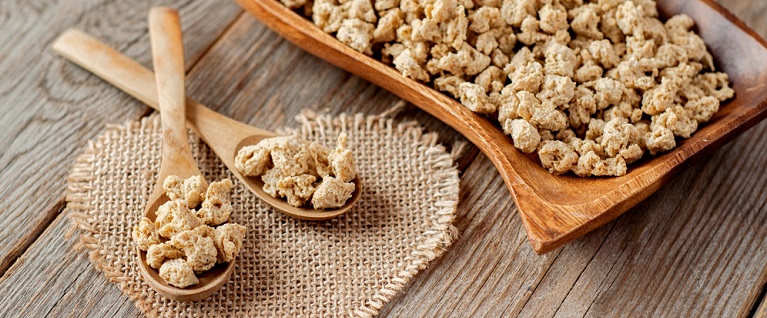Textured soy protein is a meat substitute derived from soybeans, while a similar meat alternative can also be made from other foods. It’s a highly processed food that’s made by separating (isolating) the soy protein from other ingredients in whole soybeans. Before cooking, defatted soy protein is crushed into granules or chunks and dried and rehydrated.
People have undoubtedly eaten textured vegetable protein if they have consumed a vegetarian diet or prefer meat replacements to meat. It’s a prominent ingredient in veggie burgers, veggie hot dogs, and other vegetarian meat substitutes. Textured soy protein has a bland flavor by itself, therefore spices and other flavorings can easily be added to make it taste like the meat product it’s emulating.
Must Read: Why Herbal Products Are Here To Stay Even in 2022
Textured Soy Protein is also commonly found in foods that contain meat, such as frozen or canned pasta dishes. Because its texture is comparable to that of meat, it can be used as a meat extender, giving the impression that the meal contains more expensive meat.
TSP stands for textured vegetable protein, and other names for it include textured vegetable protein (TVP), soy meat, and soya chunks. Under any of those names, it might be present on food labels. TVP, or textured vegetable protein, is a trademark of Archer Daniels Midland Company, which manufactures it only from soybeans.
Because soy is one of the eight major allergens, food goods containing soy-based textured vegetable protein must state that they contain soy in the United States.
Must Read: What is HPV? Questions About HPV | #HPV Search Kiya Kya?
Production and Manufacturing
Soy flour that has had the fat removed is used to make textured soy protein. The flour is pressure boiled and then dried. Extrusion cooking is the technical term for the process. It’s a thermo-mechanical technique that combines high heat, high shear, and high pressure to create a product that can be molded into a variety of shapes and sizes for diverse applications. The method can be varied (using different temperatures), which can vary the texture, flavor, and nutritional composition of the finished product.
Health Advantages
The majority of health professionals agree that eating more plant-based foods and fewer animal-based foods can improve health.
As a result, one would agree that substituting textured vegetable protein for beef would be a healthier option. However, there is substantial debate over this concept, and the evidence supporting various points of view is equivocal.
Soy protein contains all of the amino acids that humans require. Some medical professionals promote it as a potentially healthier meat substitute because it is a complete source of protein. In fact, studies suggest that eating soybeans lowers cholesterol and lowers the risk of heart disease. In addition, soy consumption can help alleviate menopause symptoms, enhance bone density, and reduce the incidence of fractures in postmenopausal women.
Must Read: Emergency Treatment for High Blood Pressure at Home
However, textured soy protein is a highly processed form of soy protein, and the majority of it is generated from genetically modified soybeans. According to several studies, textured soy protein, such as soy protein powder, may not provide the same health benefits as raw soybeans.
Soybeans, for example, are high in healthful omega-3 and monounsaturated fats, but textured vegetable protein, although being manufactured from soybeans, has almost little fat, so consumers don’t get those advantages. Furthermore, the nutritional value of textured soy protein might be affected by the varied processing processes used to make it.
Must Read: 10 Benefits of Drinking Apple Cider Vinegar – 10 Different Ways to Use It
Potential Negative Effects
Because textured soy protein is made from soy, it should be avoided if one has a soy allergy. Consumers could have a major allergic response if they consume a veggie burger or another food that contains TSP.
Because textured soy protein might be rich in sodium, it may not be the ideal choice for everyone. Including natural protein-rich foods like nuts, seeds, whole grains, and legumes in the diet can be a safer choice. In any case consumers should consult a doctor about textured soy protein intake.
Read more: #HPV Search Kiya Kya?
Alternatives
Although textured soy protein is safe to eat, not everyone who follows a vegetarian diet (or simply eats a lot of veggies) agrees that replacing meat with highly processed soy protein meals is a good choice. There are many of options, fortunately.
Seitan – Because of the protein level, nutritionists and dietitians recommends this wheat gluten-based product over TSP. Seitan has 31 grams of protein every 3 ounce serving, but TSP has only 8 grams per 3 ounce serving.
Tofu – Tofu is the unprocessed form of TSP, and it’s just as versatile: it absorbs the taste of anything it is prepared with. It also contains all of the essential amino acids as a soy product.
Grains – Whole grains are high in protein, and Michelle Davenport, a nutrition researcher at New York University School of Medicine, suggests quinoa because it contains all of the essential amino acids. For diversity, try using different grains like millet and amaranth.
Nuts and Seeds – Flax seeds, hemp seeds, almonds are even better than most nuts. Because nuts and seeds are high in healthful fats, they’re also high in calories. Use them as a garnish rather than a primary protein source.
Beans – A wide range of legumes are available, and many of them can successfully replace meat in numerous recipes. Experts agree that black beans and lentils are the best sources of fiber and protein.
Fruits and Vegetables – People overlook the fact that veggies provide protein. Kale, avocados, and olives, among other leafy greens particularly spinach are essential for quality protein intake. A cup of broccoli contains 4 to 5 grams of protein.
Must Read: Top 27 Foods That Make You Feel Energetic
Variety is important. Because most plant proteins lack all of the required amino acids, it’s crucial to consume as many different protein sources as possible, albeit they don’t have to be consumed at the same time. The concept of blending foods is a little archaic. We don’t need to consume all of the amino acids at once. Proteins are broken down into their constituent pieces and utilized; unfinished proteins are not discarded. The great majority of people’s protein demands might be met by eating a variety of foods throughout the day. Even active individuals.
Source: – https://www.reportsanddata.com/report-detail/textured-soy-protein-market
Author Bio: –
Paroma Bhattacharya is a passionate content creator and has been a professional content writer for over half a decade. She is currently working for Reports and Data and possesses extensive knowledge in subjects related to healthcare, technology, banking, and a wide range of other industry verticals. Her articles focus primarily on balancing relevant data with engaging storytelling. She believes in providing objective facts to help people make important business decisions.
Featured Image – https://www.bobsredmill.com/





